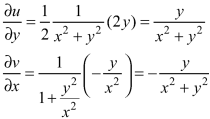Unit-6
Complex Variables
Q1) Find-

A1) Here we have-

Divide numerator and denominator by  , we get-
, we get-

Q2) If w = log z, then find  . Also determine where w is non-analytic.
. Also determine where w is non-analytic.
A2) Here we have 
Therefore-

 and
and 
Again-


Hence the C-R conditions are satisfied also the partial derivatives are continuous except at (0 , 0).
So that w is analytic everywhere but not at z = 0

Q3) Prove that 
A3) Given that



Since 

V=2xy

Now 






But 



Hence 
Q4) Show that polar form of C-R equations are-

A4) z = x + iy = 

U and v are expressed in terms of r and θ.
Differentiate it partially w.r.t. r and θ, we get-


By equating real and imaginary parts, we get-

Q5) Prove that the real and imaginary parts of the function w = log z satisfies C-R equations.
A5)
We put  and
and  to separate the real and imaginary parts of log z.
to separate the real and imaginary parts of log z.
w = log z = log (x + iy)


Here 

On differentiating u and v, we get-

From the above two equations, we have-

Again differentiating u and v, we get-

We have form the above equation-

Hence the C-R condition is satisfied.
Q6) Show that the curve u = constant and v = constant cut orthogonally at all intersections but the transformation w = u + iv is not conformal. Where-

A6)
Let  …………. (1)
…………. (1)
Differentiate (1), we get-

 …………… (2)
…………… (2)
Now-
 …………….. (3)
…………….. (3)
Differentiate (3), we get-
 ………. (4)
………. (4)
As we know that for the condition for orthogonallity, from (2) and (4)

So that these two curves cut orthogonally.
Here,

And

Here the C-R equation is not satisfied so that the function u + iv is not analytic.
Hence the transformation is not conformal.
Q7) How that the bilinear transformation w=  transforms
transforms  in the z-plane to 4u+3=0 in w-plane.
in the z-plane to 4u+3=0 in w-plane.
A7)
Consider  the circle in z-plane
the circle in z-plane

 = 0
= 0



Thus, centre of the circle is (h,k) c(2,0) and radius r=2.
c(2,0) and radius r=2.
Thus in z-plane it is given as  =2....(1)
=2....(1)
Consider w= 
W(z-4) = 2z+3
Wz-4w=2z+3
Wz-2z=4w+3
Z(w-2) = (4w+3)
 z =
z = 
z-2 =  - 2
- 2




Q8) Evaluate  where C is |z + 3i| = 2
where C is |z + 3i| = 2
A8)
Here we have-

Hence the poles of f(z),

Note- put determine equal to zero to find the poles.

Here pole z = -3i lies in the given circle C.
So that-




Q9) Evaluate the integral given below by using Cauchy’s integral formula-

A9) Here we have-

Find its poles by equating denominator equals to zero.

We get-

There are two poles in the circle-
Z = 0 and z = 1
So that-



Q10) Evaluate  where c;|z|=4
where c;|z|=4
A10)
Here f(z)=
Poles are 
Sin iz=0

Poles 
Lie inside the circle |z|=4
The given function  is of the form
is of the form 
Its pole at z=a is 
Residue (at 


Residue at z=0=
Residue at  =
=

Residue at  are
are
Respectively -1,1 and -1
Hence the required integrand

Q11) Evaluate 
A11)
Consider 
Where c is the closed contour consisting of
1) Real axis from 
2) Large semicircle in the upper half plane given by |z|=R
3) The real axis -R to  and
and
4) Small semicircle given by |z|=
Now f(z) has simple poles at z=0  of which only z=
of which only z= is avoided by indentation
is avoided by indentation


Hence by Cauchy’s Residue theorem


Since  and
and
Hence by Jordan’s Lemma 
Also since 
Hence 
Hence as 

Equating imaginary parts we get
